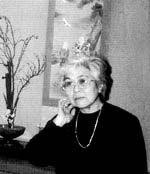A Flood of Memories
by Ryo Tsuiki
Nagasaki Reception, 1951-64

Ryo Tsuiki
One day when I was taking it easy following the signing of the Peace Treaty and my release from my previous job at the US Military Government (later called the Civil Government), I was unexpectedly called to ABCC, where Miss Cavagnaro said to me, “Won’t you work at ABCC? A medical division is going to be opened at Nagasaki ABCC shortly and we would like you to do reception work. If you agree, you will go to Hiroshima next week and receive training there for a short time.” I immediately accepted the offer as I had no particular reason to refuse. This was early in the summer of 1951.
That autumn the clinic opened and the pediatrics program was initiated with the arrival of Drs. Stanley and Phillis Wright. Dr. Stanley Wright used to come to the reception room after he finished examining patients and explain politely to each mother that she must recognize her child as an individual and think about what she can do as a mother. Although this is common sense now, the idea was altogether new then and, hearing it, I also felt awakened.
One day, a mother came to the clinic carrying a young girl on her back. The girl was about 10 years old and, although unable to walk herself, she seemed a little too big to be carried on the back. When Dr. Phillis Wright asked, “Why are you carrying such a big girl on your back?” the mother was at a loss what to say. At that time, we did not think of wheelchairs, much less that one would be able to walk by practicing. After examination, Dr. Phillis Wright said sternly: “Let’s have her practice walking. What do you think will happen to this child when you become old and can no longer carry her on your back?” Since then, the mother and daughter started to visit the Clinic once a week.
Little by little the child’s legs became stronger. I still see the mother’s face when she reported that her daughter had become able to stand for a moment unaided by her, holding onto the back of a chair, and when she reported that her daughter was able to stand for a time without holding onto anything. I can still hear Dr. Wright’s voice encouraging the girl to take another step.
One day before long, the girl came in through the entrance by herself using a pair of crutches.
I am presently working at a volunteer center where I meet people, and the families of people with various disabilities. Now the things I learned at ABCC more than 30 years ago have become my treasures: the importance of wheelchairs and rehabilitation and, most important of all, the attitude of belief in the limitless capacities of human beings.
I understand that the service (I presume to say “service”) of many atomic bomb survivors rendered over 40 years since the establishment of ABCC contributed greatly in coping with the disastrous Chernobyl accident of 1986. However, it surely is not for such a purpose that the ABCC-RERF has continued to exist. I wish to close this poor piece of writing with an expression of hope that the day will come when the service of the A-bomb survivors will be availed of not for such a sorrowful purpose but as a basis for the building of a more healthy and happy community.
This article was originally published in RERF Newsletter 14 (40th anniversary special issue):67-68, 1988.

